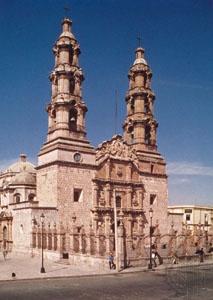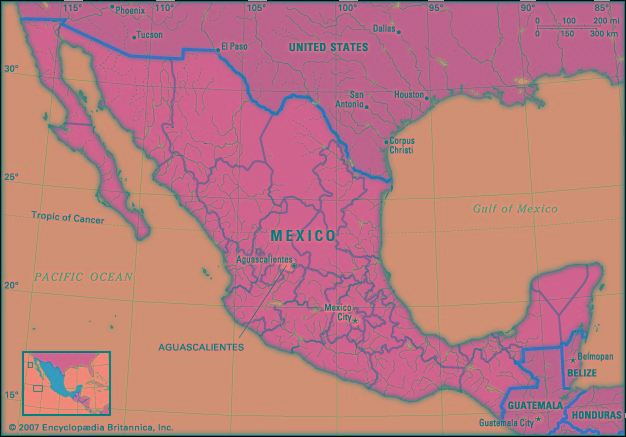Aguascalientes
Mexico
 city, capital of Aguascalientes estado (state), central Mexico. It is located in the south-central part of the state on the Mesa Central, 6,194 feet (1,888 metres) above sea level, on the left (east) bank of the Juchipila (Aguascalientes) River. Founded in 1575 and designated a town in 1661, Aguascalientes (“Hot Waters”) was named for the area's once-numerous thermal baths, which were considered medicinal. It became the capital when the state was created during the 1850s, and it is now home to more than three-fifths of the state's population. Aguascalientes is sometimes called the “Perforated City,” because of the labyrinth of tunnels dug beneath it by the area's pre-Columbian inhabitants.
city, capital of Aguascalientes estado (state), central Mexico. It is located in the south-central part of the state on the Mesa Central, 6,194 feet (1,888 metres) above sea level, on the left (east) bank of the Juchipila (Aguascalientes) River. Founded in 1575 and designated a town in 1661, Aguascalientes (“Hot Waters”) was named for the area's once-numerous thermal baths, which were considered medicinal. It became the capital when the state was created during the 1850s, and it is now home to more than three-fifths of the state's population. Aguascalientes is sometimes called the “Perforated City,” because of the labyrinth of tunnels dug beneath it by the area's pre-Columbian inhabitants.The city has long had important railroad repair shops, cotton and other textile factories, potteries, tobacco factories, distilleries, and other industries. Its diversified economy now also includes Japanese- and American-owned automobile plants, electronic assembly plants, pharmaceutical laboratories, and other high-technology industries. Aguascalientes has few extant colonial buildings. Among them is the Baroque-style 18th-century cathedral. The city is the site of the Autonomous University of Aguascalientes (1973). Its annual San Marcos Fair, held each spring, attracts large crowds. Aguascalientes has several notable museums; among them are one dedicated to José Guadalupe Posada (Posada, José Guadalupe) (one of Mexico's best-known cartoonists) and a museum of contemporary art. Pop. (2000) city, 594,092; urban agglom., 707,516.
state, Mexico

 estado (state), central Mexico. One of Mexico's smallest states, it is bounded to the west, north, and east by the state of Zacatecas and to the south and southeast by the state of Jalisco. The city of Aguascalientes is the state capital.
estado (state), central Mexico. One of Mexico's smallest states, it is bounded to the west, north, and east by the state of Zacatecas and to the south and southeast by the state of Jalisco. The city of Aguascalientes is the state capital.The Chichimec were the original inhabitants of the region. The Spanish conquered Aguascalientes in the 16th century and expanded silver mining in the area. Under the Spanish and after independence, neighbouring territories fought over Aguascalientes, and for a time it was part of Zacatecas. It became a state in 1835. During the Mexican Revolution it was the scene of bitter fighting and was occupied by various factions.
The state's relief is dominated by spurs of the Sierra Madre Occidental and the Cordillera Neo-Volcánica (Neo-Volcánica, Cordillera) rising above the Mesa Central. High elevations, between some 3,300 and 9,800 feet (1,000 and 3,000 metres), contribute to a mild climate with light rainfall. The state's Calvillo and Aguascalientes rivers form part of the Rio Grande de Santiago (Santiago, Río Grande de) system. Numerous hot springs are the basis for the state's name (from the Spanish, meaning “hot waters”) and the playful label for its residents, hidrocálidos—from hidro (a prefix meaning “water”) and cálido (“warm”).
Mining makes up a small part of the economy, as does wine making. Agriculture relies on irrigation; crops raised include chilies, corn (maize), potatoes, garlic, onions, beans, guavas, peaches, and alfalfa. The service sector, including government, trade, and tourism, dominates the economy. Tourism centres on the hot springs and the San Marcos Fair, held each spring in Aguascalientes city. Manufacturing also contributes significantly to the economy; notable products are clothing (largely exported to the United States), electronics, automobiles and automobile parts, metal goods, and dairy and beef products. Aguascalientes has an airport and good rail and highway connections with all parts of Mexico.
The executive branch of state government is led by a governor, who is elected to a single six-year term. Members of the unicameral legislature, the State Congress, are elected to three-year terms. Aguascalientes is divided into local governmental units called municipios (municipalities), each of which is headquartered in a prominent city, town, or village. The Aguascalientes municipio is the site of the state's leading cultural institutions, including the Autonomous University of Aguascalientes (founded 1973). Area 2,112 square miles (5,471 square km). Pop. (2000) 944,285; (2005) 1,065,416.
- York, Richard, 3rd duke of
- Yorkshire
- Yorkshire Post
- Yorkshire terrier
- Yorktown
- Yorktown, Siege of
- Yoro
- Yoruba
- Yoruba language
- Yoruba states
- Yosano Akiko
- Yosef Burg
- Yosemite Falls
- Yosemite National Park
- Yoshida Isoya
- Yoshida Kenkō
- Yoshida Shigeru
- Yoshida Tetsurō
- Yoshikawa Eiji
- Yoshino Sakuzō
- Yoshkar-Ola
- Yost, Fielding
- you
- Youghal
- Youghiogheny River